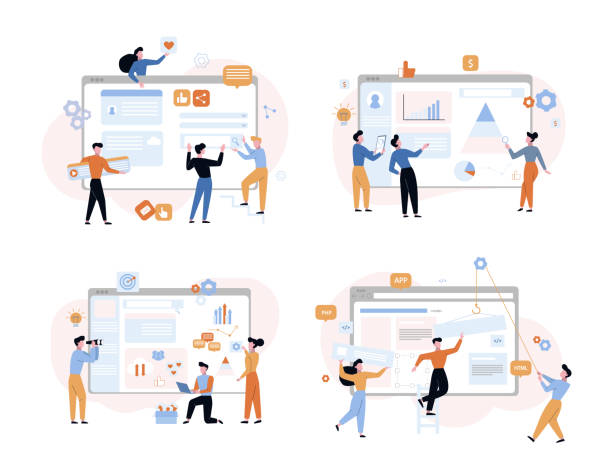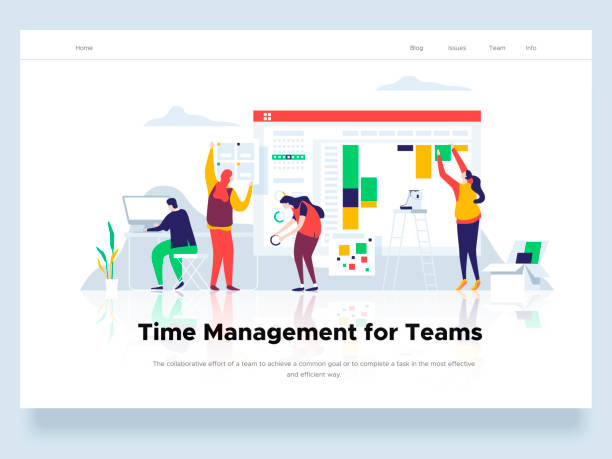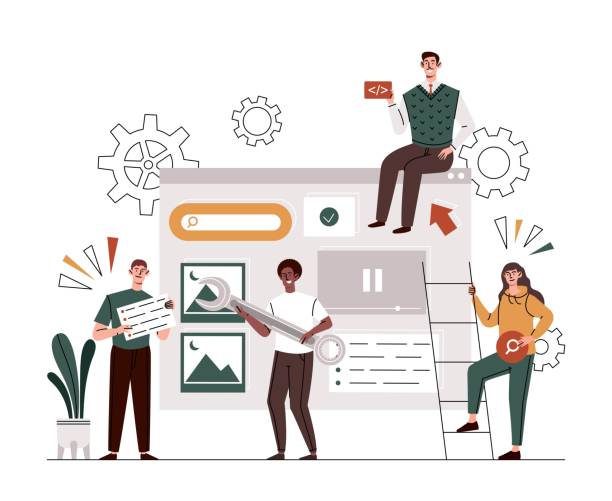Introduction to E-commerce Website Design and Its Importance

In the current digital age, e-commerce has transcended traditional business boundaries, providing an infinite platform for growth and development.
This transformation has made #eCommerce_website_design a necessity.
An e-commerce website is not merely an online storefront, but a complete ecosystem for interacting with customers, presenting products and services, and finalizing sales.
The importance of e-commerce website design lies not only in increasing access to wider markets but also in the ability to provide comprehensive information, product comparison options, and convenience of purchase for customers.
In fact, a professional e-commerce website can mean the difference between the survival and growth of a business.
This platform offers unparalleled opportunities for better understanding customers, collecting data, and personalizing the shopping experience.
By entering the online world, businesses can benefit from advantages such as reduced operational costs, 24/7 access to customers, and targeted marketing capabilities.
This explanatory section, as an initial guide, shows you why investing in e-commerce website design is not just an expense, but a strategic investment for the future of your business.
Therefore, every business, from small to large, needs a strong and effective online presence through an efficient e-commerce website to compete in today’s and tomorrow’s market.
This step opens the door to sustainable growth and increased market share, allowing you to be a leader in a world rapidly moving towards digitalization.
Are you tired of your company’s website failing to meet your expectations? Design a professional website with Rasaweb that truly reflects your business.
✅ Increased attraction of new customers and sales leads
✅ Increased credibility and trust in your brand among your audience
⚡ Get a free website design consultation!
Choosing the Right Platform for E-commerce Website Design

One of the most crucial decisions at the start of the e-commerce website design process is choosing the right platform.
This choice affects not only the launch speed but also scalability, customization capabilities, security, and maintenance costs.
Various platforms are available in the market, each with its own advantages and disadvantages.
For example, #WooCommerce, an add-on for WordPress, offers high flexibility in customization and is suitable for businesses that want complete control over their website.
However, it requires more technical knowledge.
In contrast, Shopify is a hosted solution that is very easy to use and highly suitable for beginners and small to medium-sized businesses, although it has limitations in customization and monthly costs.
Magento is also a powerful and highly flexible platform, primarily suitable for large businesses with complex needs, but due to its complexity and high costs, it is generally not recommended.
PrestaShop is also an open-source option that strikes a balance between WooCommerce and Shopify.
When choosing a platform for e-commerce website design, factors such as budget, product volume, integration needs with other systems, the team’s technical knowledge level, and long-term business plans should be considered.
Are you looking for a quick and cost-effective solution or a platform with extensive features and deep customization? These questions will guide your decision-making and help you choose the best platform to achieve your e-commerce goals.
An incorrect platform choice can lead to many problems in the future, so this step requires accurate and expert analysis.
User Interface and User Experience Design in E-commerce Websites

After selecting the platform, the most important step in e-commerce website design is to focus on #User_Interface (UI) and #User_Experience (UX).
These two concepts form the backbone of any e-commerce website’s success.
An attractive and visual UI, coupled with a smooth and hassle-free UX, not only increases user retention on the site but also directly impacts conversion rates and sales.
In UI design, elements such as color selection, fonts, images, and visual element layout are important.
These elements should be harmonious and consistent with your brand.
But UX goes beyond appearance; this concept deals with the user’s feeling when interacting with the site.
Is site navigation easy? Is the purchasing process not complicated? Is product information clearly displayed? Page loading speed, site responsiveness for different devices (mobile, tablet, desktop), and accessibility for individuals with physical limitations are also crucial UX components.
An #e_commerce_website with poor UX, even if it has excellent products, will lose customers.
Today’s users are impatient and expect their online shopping experience to be fast, easy, and enjoyable.
Continuous UI/UX optimization, through A/B tests and collecting user feedback, helps you improve your site and maximize conversion rates.
This is an ongoing process that requires attention and precise analysis of user behavior to ensure that your e-commerce website design is both beautiful and efficient.
| Feature | Good UX (Example) | Bad UX (Example) |
|---|---|---|
| Navigation | Clear and categorized menus, smart search bar | Hidden and complex menus, lack of search or inefficient search |
| Loading Speed | Under 3 seconds for most pages | Over 5 seconds, large image files |
| Mobile Responsiveness | Responsive design, correct display on all devices | Incomplete or cluttered display on mobile, requiring manual zoom |
| Purchase Process | Simple multi-step process, clear shopping cart information | Many complex steps, lack of transparency in costs |
| Product Content | High-quality images, comprehensive descriptions, customer reviews | Low-quality images, insufficient descriptions, no reviews |
The Importance of SEO in E-commerce Website Design

After the e-commerce website design phase, it’s time for it to be seen.
This is where Search Engine Optimization (SEO) plays its vital role.
#SEO goes beyond keywords and includes a wide range of techniques that help your site rank higher in Google and other search engine results.
For an e-commerce website, SEO means attracting organic and targeted traffic; traffic that is highly likely to convert into customers.
On-page SEO elements include optimizing page titles, meta descriptions, proper use of Heading tags, content quality, and product image optimization.
Each product page should have unique descriptions rich in relevant keywords.
Furthermore, Technical SEO, such as site loading speed, #mobile_friendliness, HTTPS usage, appropriate URL structure, and a sitemap, is also very important.
Google places special importance on websites that provide a good user experience. Also, Off-page SEO, which mainly involves building high-quality backlinks from reputable sites, helps increase your domain’s credibility and authority.
A strong SEO strategy for e-commerce website design helps you stay ahead in the fierce online market competition and ensures that potential customers find you.
Did you know that 90% of users only check Google’s first page results? This statistic itself demonstrates the undeniable importance of SEO in the success of an #e_commerce_website.
Without proper SEO, even the best e-commerce website design may not be seen and may fail to achieve its business objectives.
Does your current corporate website present a worthy image of your brand and attract new customers?
If not, turn this challenge into an opportunity with Rasaweb’s professional corporate website design services.
✅ Significantly improves your brand’s credibility and image.
✅ Paves the way for attracting new leads and customers.
⚡ For a free and specialized consultation, contact Rasaweb now!
Security and Payment Gateways in E-commerce Website Design

One of the biggest concerns for customers when shopping online is the security of their personal and banking information.
Therefore, in the e-commerce website design process, prioritizing security is of vital importance.
#e_commerce_website_security involves various layers.
First, an SSL certificate (HTTPS) is essential.
This certificate encrypts information exchanged between the user and the server, preventing eavesdropping or tampering.
The green padlock symbol in the browser is a sign of site security for users and builds their trust.
Also, the website must comply with PCI DSS security standards, especially if it directly processes credit card information (although this is often done through intermediary payment gateways).
Protection against cyberattacks such as SQL injection, XSS, and DDoS attacks should also be considered.
Choosing a #secure_and_reliable_payment_gateway is also an integral part of security in e-commerce website design.
Payment gateways must have strong security protocols and use advanced encryption to protect customers’ financial information.
In Iran, there are numerous banking and intermediary payment gateways, each with its own specific rules and security requirements.
Ensuring that the payment process is smooth, fast, and completely secure is key to success in online sales.
Customers must feel completely secure to finalize their purchase with peace of mind.
Any security flaw can lead to a loss of customer trust and severe damage to your business’s reputation.
This specialized section teaches you how to achieve a trustworthy and successful e-commerce website design by correctly implementing security measures and choosing appropriate payment gateways.
Content and Product Management in E-commerce Websites

One of the key aspects of successful e-commerce website design is how products and content are managed and presented.
#product_management goes beyond simply uploading images and prices; this process involves creating engaging and accurate content for each product that can persuade the customer to buy.
For each product, high-quality images from different angles, comprehensive and detailed descriptions including features, benefits, usage instructions, and technical information are needed.
Using product videos can also improve user experience and increase conversion rates. Additionally, proper product categorization, use of tags, and advanced filter and search capabilities help users easily find the product they are looking for.
An efficient Inventory Management System should also be in place to prevent selling out-of-stock products.
But content is not limited to product descriptions alone.
#content_marketing plays a significant role in attracting organic traffic, building brand awareness, and communicating with customers.
The blog section of the e-commerce website can host educational articles, buying guides, industry-related news, and entertaining content.
This content not only helps improve SEO but also transforms your website into a credible information source.
The Frequently Asked Questions (FAQ) section, customer reviews, and even discussion forums can also be considered as parts of content management that help increase user trust and engagement.
A strong content management strategy in e-commerce website design allows you not only to sell your products but also to build a community of loyal customers and be recognized as an authority in your industry.
This is a continuous process that requires creativity and meticulous planning.
Marketing and Advertising for E-commerce Websites

After completing the e-commerce website design, it’s time to attract customers.
Having a beautiful and efficient website without a strong marketing strategy is like having a physical store in the desert.
#digital_marketing for an e-commerce website encompasses a wide range of channels and tactics whose ultimate goal is to increase brand awareness, drive traffic, and ultimately, boost sales.
One of the most effective methods is social media marketing.
An active presence on platforms like Instagram, Telegram, and LinkedIn (depending on the product type and audience) can help build a community of followers, engage with them, and introduce new products.
#paid_advertising is also an important part of the marketing strategy.
Google Ads allows you to appear in top positions in search results and Google Display Networks, while social media advertising (such as Instagram Ads) provides the ability to precisely target audiences based on their interests and behavior.
Email marketing also remains one of the most effective methods for customer retention and informing about discounts and new products.
Building an email list of customers and sending engaging and personalized newsletters can significantly increase customer return rates.
Affiliate Marketing programs and collaborations with influencers can also be effective ways to expand reach and increase sales.
Finally, data analysis and continuous optimization of marketing campaigns are crucial to ensure a high Return on Investment (ROI).
This news and analytical section shows you how an integrated marketing strategy can guarantee and accelerate the success of your e-commerce website design.
| Marketing Channel | Key Advantages | Considerations |
|---|---|---|
| SEO (Search Engine Optimization) | Organic and sustainable traffic, long-term credibility | Requires time for results, high competition |
| Pay-Per-Click (PPC) Advertising | Fast results, precise targeting, high scalability | Costly, requires continuous management and optimization |
| Social Media Marketing | Increased brand awareness, customer engagement, referral traffic | Requires engaging content, algorithm changes |
| Email Marketing | High ROI, direct communication with customers, repeat sales | Requires email list building, risk of being marked as spam |
| Content Marketing | Builds credibility and trust, improves SEO, attracts target audience | Time-consuming, requires continuous production of high-quality content |
Customer Support and After-Sales Services in E-commerce Websites

The success of an e-commerce website design is not limited to selling products; rather, it depends on its ability to build and maintain lasting relationships with customers.
#customer_support and #after_sales_services are crucial not only for resolving issues but also for building customer loyalty and satisfaction.
Today’s customers expect to receive effective and fast support at every stage of the purchase process, from pre-purchase to post-delivery.
Providing multiple communication channels such as online chat, a direct phone number, email, and a comprehensive Frequently Asked Questions (FAQ) section is essential.
Online chat can quickly answer user questions and even guide them through the purchase process.
Quick and professional responses to customer comments and complaints, even in public social media spaces, demonstrate your commitment to customer satisfaction.
Return and warranty policies must also be clear, transparent, and fair.
These policies should be easily accessible on the website so that customers can make purchases with full awareness.
An easy and hassle-free return or exchange process can turn a negative customer experience into an opportunity to strengthen the relationship.
Finally, personalizing the customer service experience, such as sending thank-you emails, post-purchase follow-ups, or offering special deals based on purchase history, can significantly increase customer loyalty.
Did you know that attracting a new customer is up to 5 times more expensive than retaining an existing one? This statistic shows that investing in after-sales services and customer support in e-commerce website design is a smart investment that contributes to the sustainable growth of your business.
This informative and engaging section highlights the importance of being human-centric in e-commerce.
Does your current corporate website present a worthy image of your brand and attract new customers?
If not, turn this challenge into an opportunity with Rasaweb’s professional corporate website design services.
✅ Significantly improves your brand’s credibility and image.
✅ Paves the way for attracting new leads and customers.
⚡ For a free and specialized consultation, contact Rasaweb now!
Data Analysis and Continuous Optimization of E-commerce Websites

A successful e-commerce website design never remains static.
Instead, it is continuously improving through #data_analysis and #continuous_optimization.
Web analytics tools like Google Analytics provide valuable information about user behavior, site traffic, conversion rates, and the website’s strengths and weaknesses.
Do you know which pages receive the most visits? Where do users come to your site from? Which products sell the most and which ones need improvement? These questions are just some of the insights that can be gained from data analysis.
By using this data, you can make evidence-based decisions to improve your website’s performance.
For example, if you notice that the Bounce Rate on a particular page is high, you can examine and improve that page’s content, design, or loading speed.
Conducting A/B tests for various site elements, such as Call-to-Action (CTA) buttons, product page layouts, or the payment process, helps you find the best versions that yield the highest conversions.
Gathering direct feedback from customers through surveys or feedback forms can also reveal hidden weaknesses.
This analytical approach and thought-provoking content encourage you to always ask yourself: “How can I improve the customer experience and increase sales?” Continuous optimization is an endless process that ensures your e-commerce website design is always at its peak performance and adapts to changing market and customer needs.
This approach not only helps increase sales but also ensures that your investment in e-commerce website design yields the best possible return.
The Future of E-commerce Website Design and New Trends

The world of e-commerce is rapidly evolving, and the future of e-commerce website design is no exception.
For long-term success, businesses must constantly monitor new trends and adapt to them.
#new_trends in e-commerce website design include the use of Artificial Intelligence (AI) and Machine Learning (ML) to personalize the shopping experience.
These technologies can personalize product recommendations based on purchase history and user behavior, provide intelligent chatbots for customer support, and even optimize inventory.
Augmented Reality (AR) and Virtual Reality (VR) are also changing how customers interact with products; for example, customers can virtually try furniture in their homes or view clothes on 3D models.
Optimization for voice search has also gained increasing importance, as the number of users of voice assistants like Google Assistant and Siri is growing.
Headless Commerce is another specialized trend where the website’s front-end is separated from the back-end.
This separation gives businesses more flexibility in designing and implementing the user experience and allows content to be published on various platforms (website, mobile app, digital kiosks).
Sustainability and ethics have also become important topics in e-commerce, and consumers are increasingly looking for brands that reflect their values.
Are you ready for these changes? This news and thought-provoking content helps you look at the future of e-commerce website design with an open mind and adjust your strategies to stay ahead in today’s and tomorrow’s competitive market.
Investing in emerging technologies and adapting to changing consumer needs is key to survival and growth in this field.
Frequently Asked Questions
| Question | Answer |
|---|---|
| What is e-commerce website design? | It is the process of building and developing a website for buying and selling products or services online. |
| What features should an e-commerce website have? | Product management, shopping cart, online payment gateway, user account section, product search and filter options. |
| What is the importance of User Experience (UX) in e-commerce website design? | Good UX leads to easy navigation, a smooth purchase process, and ultimately increased customer satisfaction and conversion rates. |
| Why is SEO important for an e-commerce website? | SEO helps your website rank higher in search engine results and attract more traffic, leading to more sales. |
| What platforms are available for e-commerce website design? | Ready-made platforms like WordPress (with WooCommerce), Shopify, PrestaShop, as well as custom design options are available. |
And other advertising agency services by Rasaweb in the field of advertising
- Smart Advertising Campaign: A creative platform to improve customer acquisition by customizing user experience.
- Smart Social Media: Revolutionize customer behavior analysis with intelligent data analysis.
- Smart Customer Journey Map: A combination of creativity and technology for campaign management through custom programming.
- Smart Data Analysis: A professional solution for customer acquisition focusing on attractive UI design.
- Smart Digital Branding: A specialized service for increasing sales growth based on marketing automation.
And over hundreds of other services in internet advertising, advertising consultation, and organizational solutions
Internet Advertising | Advertising Strategy | Advertorial
Sources
E-commerce Website Design Guide: From Zero to Hundred
E-commerce Website Design
What is E-commerce Website Design
What is E-commerce Website Design and What are its Benefits?
? Your business deserves the best! With Rasaweb Afarin Digital Marketing Agency, from professional website design to comprehensive digital marketing strategies, realize your digital dream.
📍 Tehran, Mirdamad Street, next to Bank Markazi, Southern Kazeroun Alley, Ramin Alley, No. 6
